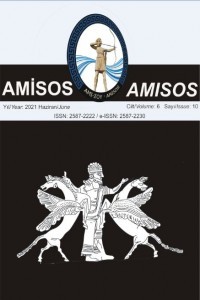Sacred Animals and Fantastic Creatures of Urartian Belts – Mythological Reflections of Urartian Civilization
Urartu kemerleri, kutsal, hayvanlar, fantastik, yaratıklar, mitolojik, yansımalar
Sacred Animals and Fantastic Creatures of Urartian Belts – Mythological Reflections of Urartian Civilization.
Urartian belts, sacred, animals, fantastic, creatures, mythological, reflections,
___
- Azarpay, G. 1990 Urartian Art and Artifacts: a Chronological Study, Berkeley and Los Angeles, University of California Press, p. 2
- Bonacossi, D. 1995 “Una cintura di bronzo Urartea nel Monastero della Congregazione Mechitarista Armena dell’isola di San Lazarro – Venezia”, Studi Micenei ed Egeo-Anatolici 35:139
- Bonacossi, D. 2009 “Urartian Bronze Belts in the National Museum of Aleppo”, Zeitschrift für Assyriologie und Vorderasiatische Archäologie 89/1:94
- Curtis, J. 1996 “Urartian Bronze Belts”, A Zeitschrift für Assyriologie und Vorderasiatische Archäologie 86/1:119
- Darke, D. 2011 Eastern Turkey – 2-nd Edition, Connecticut USA, The Globe Pequot Press Inc., p. 323
- Esayan, S., Hmayakyan, S. 1990 “The Urartian Clothing”, Historico-Philological Journal 3:203
- Hamilton, R.W. 1965 “The Decorated Bronze Strip from Gushchi”, Anatolian Studies 15:43
- Hmayakyan S.G. 1990 The State Religion of the Kingdom of Van, Yerevan, Academy of Sciences of Armenia, page 35.
- Hooker, J.T. 1990 Reading the Past: Ancient Writing from Cuneiform to the Alphabet, Berkeley and Los Angeles, University of California Press /Trustees of British Museum, p. 54
- Salvatori. S. 1976 “Notes on the Chronology of Some Urartian Artifacts”, East and West 26/½:92
- Salvatori, S. 1976 “An Urartian Bronze Strip in a Private Collection”, East and West 26/½: 99
- Steadman, S., McMahon, G. 2011 The Oxford Handbook of Ancient Anatolia: (10,000 – 323 BCE), New York, Oxford University Press, Inc., p. 3.
- Steadman, S., McMahon, G. 2011 The Oxford Handbook of Ancient Anatolia: (10,000 – 323 BCE), New York, Oxford University Press, Inc., p. 4.
- Taşyürek, O. 1977 “Adana Bölge Müzesindeki “Dedeli” Bronz Urartu Kemeri – The “Dedeli” Bronze Urartian Belt in the Adana Regional Museum”, Türk Arkeoloji Dergisi 24/2:157
- Taşyürek, O.A. 1977 “The Urartian Bronze hoard from Giyimli”, Philadelphia University Museum Expedition Summer 1977, 19/4:18
- ISSN: 2587-2222
- Yayın Aralığı: Yılda 2 Sayı
- Başlangıç: 2016
- Yayıncı: Davut YİĞİTPAŞA
ANTİK DÖNEM YUNAN DÜNYASI’NDA ÖLÜM KAVRAMI VE BUNUNLA İLGİLİ BAZI BETİMLER
MAGNESIA ARTEMISION’U KURBAN ÇUKURU A AÇMASINDAN ELE GEÇEN PİŞİRME KAPLARI
ANKARA/ALTINDAĞ İLÇESİ ULUS MEVKİİ’NDE BULUNAN ANTİK ROMA TİYATROSU
AMİSOS’TA LAHİT MEZAR GELENEĞİ
AMİSOS TERİTORYUMUNDA BİR MOZAİK KAZISI
XI. ULUSLARARASI BALKAN TARİHİ KONGRESİ
PALEOLİTİK DÖNEMDE İNSAN TÜRLERİ
KÜLTÜR VE SANAT ADAMLIĞINDAN RESSAMLIĞA UZANAN BİR PORTRE: CELAL ESAD ARSEVEN
